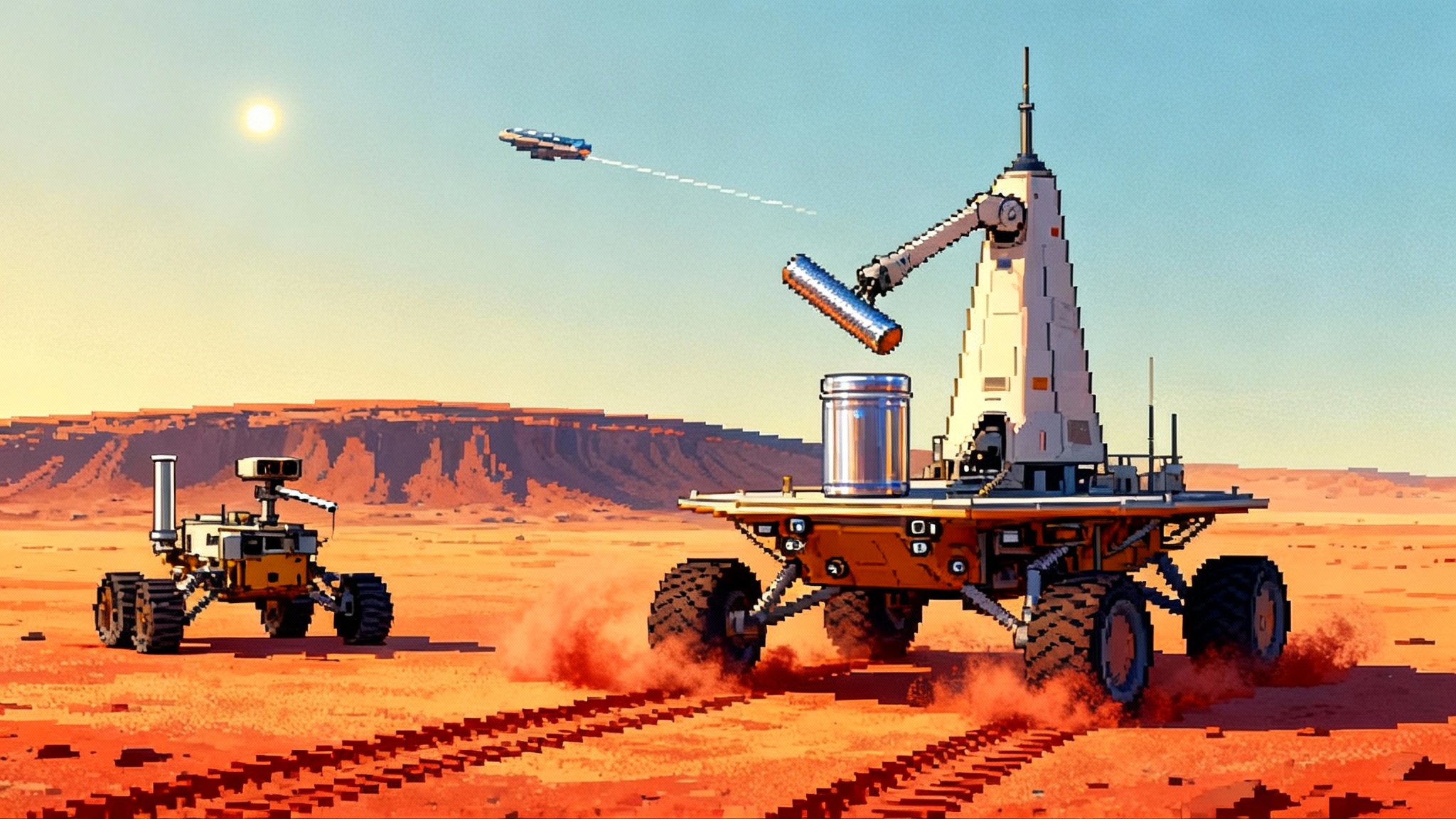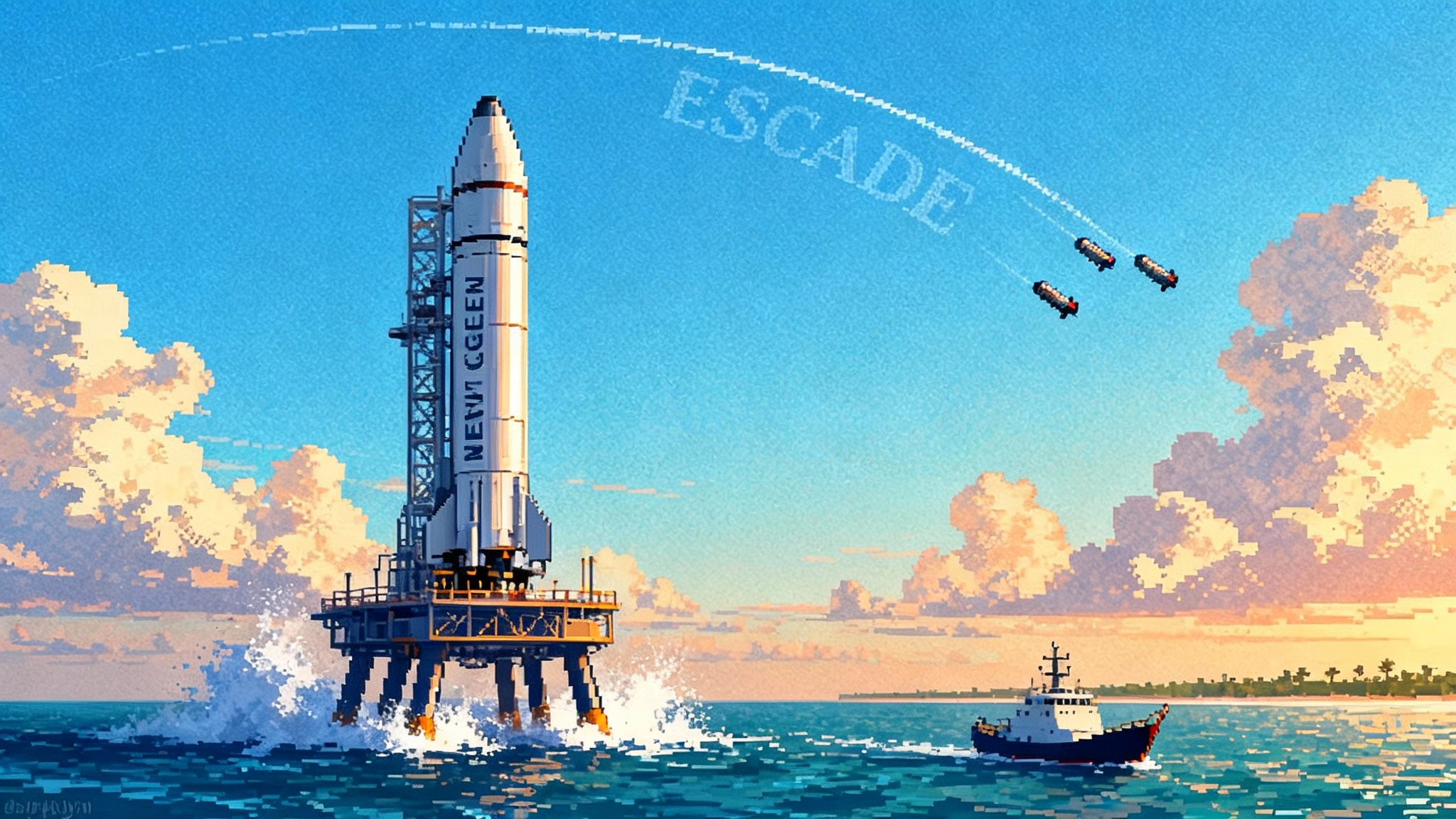How NASA’s 2025 Mars Sample Return Reboot Gets Faster
In 2025 NASA pivoted Mars Sample Return to an industry-led, firm-fixed-price competition. Here is what changed, what Europe brings, the critical technologies, and the milestones toward a 2026 downselect and a mid 2030s Earth return.

The year NASA changed course
In 2025, NASA took a red pencil to the most ambitious planetary mission on its books and rewrote the plan. Mars Sample Return, a once-in-a-generation effort to bring rocks and dust that the Perseverance rover has cached in Jezero Crater back to Earth, moved from a government-driven design to a competition among industry teams under firm fixed price contracts. The goal is explicit: fly sooner, spend less, and keep the science intact. NASA also signaled parallel formulation paths to speed learning and competition, and NASA detailed two landing options in January 2025.
This is not a cosmetic change. It is a structural pivot that shifts risk, sharpens incentives, and gives multiple companies space to propose leaner architectures. The agency is targeting an Earth return in the mid 2030s and plans a 2026 downselect after a head-to-head comparison of competing approaches. In the interim, everything from the lander shape to how samples are sealed for the trip home is back on the table.
Why the old plan stalled
To understand the 2025 reboot, it helps to revisit what came before. The pre reboot concept sprawled into a multi element campaign: a heavy lander to deliver a sample retrieval rover and a Mars Ascent Vehicle, helicopters to fetch backup sample tubes, an orbiter with a capture system, and a complex choreography between them. Technical maturity lagged while cost forecasts climbed. The mission began to look like a first time build of several hard things at once, which is the template for delays.
Complexity was the quiet tax. Every additional element needed its own testing, its own integration stages, and its own failure modes. When budgets tightened, a domino effect followed. Teams looked for scope cuts that would not compromise science, but too many pieces were stitched together to prune cleanly. By the end of 2024, the agency signaled that a reset was likely. The 2025 pivot made it official.
What changed in 2025
NASA switched to a model that invites industry teams to propose complete Mars Sample Return architectures and to price them at a firm fixed amount for defined phases. That means the government states the outcomes it needs, provides key interfaces and standards, and lets contractors compete on how to meet them. Payment is tied to delivery, not hours burned. If a company finds a faster, simpler way, it benefits directly. If problems drag, the contractor absorbs more of the overrun risk.
The agency also made schedule the co equal partner of cost. Instead of one official architecture that everyone must defend, there are multiple credible paths that will be judged against the same safety and science yardsticks. Some proposals shift surface power from solar arrays to a radioisotope system to ride through dust season, as described in NASA’s January 2025 update.
Finally, the reboot leaned into what industry does well: integration of proven hardware, creatively repackaged. The clearest example is the lander and ascent stack. Teams no longer need to preserve any one legacy design. They can size the lander to their ascent vehicle choice, use heritage avionics, and cut elements that add complexity without meaningfully reducing scientific return.
Europe’s role is still central
Mars Sample Return has always been a transatlantic effort. Europe supplies the Earth Return Orbiter, which ferries the samples from Mars orbit to Earth, and the Sample Transfer Arm, a robotic system designed to move cores from a lander deck into the ascent vehicle’s container. In the reboot, the handshake remains: Europe brings the long range transport and precision robotics, the United States brings the lander and ascent from the surface, and both sides co manage the handling and planetary protection protocols. For a technical snapshot of the orbiter, see NASA’s Earth Return Orbiter overview.
There is new flexibility at the edges. A lighter orbiter could be paired with a streamlined capture system if the sample container in Mars orbit is easier to acquire. The Sample Transfer Arm may be adapted to simplified surface operations if the lander layout changes. What did not change is the partnership logic. Europe lowers overall risk by specializing in a complex, deep space electric propulsion orbiter and high fidelity manipulation. The United States lowers overall risk by focusing on entry, descent, landing, and the short, intense ascent from Mars.
The key technologies that now drive the schedule
The reboot narrows the critical path to a handful of technologies and operations. Watch these closely. They will make or break the faster, cheaper promise.
The lander and the art of landing light
Landing a capable payload on Mars demands precision. The thinner atmosphere gives you less aerodynamic braking than on Earth, but still enough to heat and buffet a spacecraft. A lighter, more compact lander is easier to test and cheaper to launch. It also buys margin for ascent mass or extra thermal shielding.
Industry teams are expected to draw heavily from proven entries. Heat shields and supersonic parachutes that have flown at Mars can be adapted. Terminal descent can leverage heritage terrain relative navigation and throttleable engines. The novelty is in integration. If the lander arrives with the Mars Ascent Vehicle already integrated, the stack avoids on site assembly. That reduces surface operations time and risk.
A crucial trade is whether to include a dedicated sample fetch rover. The 2025 pivot encourages designs that rely primarily on Perseverance to deliver cores directly to the lander, with light backup options for contingency pickup. Fewer movers on the chessboard means fewer ways to lose.
The Mars Ascent Vehicle is the beating heart
The Mars Ascent Vehicle, often shortened to MAV, is a small rocket that must perform exactly once in an environment where no rocket has ever flown to orbit. It needs to be compact, highly reliable, and tolerant of Mars surface temperatures and dust. Success here is not about raw performance. It is about clean interfaces and ruthless simplicity.
Expect industry to reduce parts count, use as much solid propulsion as practical, and minimize moving mechanisms. Solid motors have fewer failure points and can sit loaded on a cold surface for months. Where liquid stages are necessary, teams will be conservative with propellant choices and thermal control, prioritizing long duration storage over finesse. The ascent guidance problem is also manageable if the vehicle knows what orbit it needs to reach and the orbiter can trim the final geometry. That is another place where partnership with the orbiter team pays off.
On Mars sample handling must be clean and quick
Between opening the lander’s deck and sealing the container that rides atop the Mars Ascent Vehicle, there is a lot of choreography. The Sample Transfer Arm has to pick up serialized cores, verify integrity, pass them through contamination control features, and load them into a container that will survive launch, vacuum, and reentry years later. The 2025 concept trims motions and tools to the minimum set that protects the science.
On the surface, simpler is better. Fewer handoffs, simpler end effectors, and standardized tube interfaces all shorten the timeline and lower the probability of a stuck joint or an alignment error. These choices are not glamorous, but they are the quiet backbone of the new plan.
Mars orbit rendezvous and the capture ballet
Once the ascent vehicle reaches orbit and releases its payload, the Earth Return Orbiter must find, approach, and capture it. This is orbital mechanics and robotics at the edge. In the reboot, capture systems emphasize robust relative navigation and forgiving fixtures. Instead of perfect docking like a space station, think of a net or a soft capture ring that can accept a small misalignment and then center the container for transfer into a sealed vault.
The orbiter’s propulsion is almost certain to lean on solar electric thrusters for the long cruise legs, with chemical propulsion reserved for fast burns. Flight software will be designed to tolerate optical occlusions from dust or glare and still maintain track. Again, industry can draw from decades of rendezvous experience while tuning for Mars lighting and geometry.
Earth entry is the final gate
When the orbiter releases the Earth Entry System near home, a heat shield and a simple capsule need to do one job very well. They must keep the samples cold enough and clean enough to preserve science, and land them at a controlled site where a recovery team and a biosecurity protocol are waiting. That design space is intentionally conservative. Heritage capsule shapes, robust ablative materials, and predictable ballistic trajectories keep surprises out of the landing day playbook.
The 2026 downselect and the milestones to watch
NASA’s calendar now has a heartbeat. Here are the markers that will tell you whether the reboot is real and on pace.
- 2025 industry studies and risk retirements: Teams spend the year turning concepts into hard mass budgets, thermal margins, and testable mockups. Expect subsystem breadboards for the Mars Ascent Vehicle ignition train, sample handling end effectors, and avionics that run in relevant environments. The most credible teams will demonstrate closed loop robotic handling of flight like tubes and will fire subscale motors or ejectable stages in vacuum chambers.
- Early to mid 2026 Preliminary Design Readiness: Before the downselect, NASA will examine whether each team’s design can close. That means margins on mass and power, environmental test paths for dust and thermal cycles, and a clear plan to integrate the lander and ascent stack without heroics. Watch for announcements that specific environmental tests have passed, or that a team has locked its lander deck layout.
- Late 2026 downselect: The agency chooses one primary architecture and may retain a backup option for targeted subsystems. At this point, long lead procurements begin. Vendors for motors, structures, and avionics move from study awards to production contracts. If the pivot is working, the selected provider will already have suppliers under letter contracts so fabrication starts quickly.
- 2027 to 2028 design closure: The winner will push to Critical Design Review. This is where drawings freeze, test articles build, and the verification plan gets real. Expect qualification of the ascent vehicle motors, vibration and acoustic tests of the integrated lander, and hardware in the loop rehearsals for capture in Mars orbit.
- Late 2020s to early 2030s launches: The mission profile determines which element goes first, but a logical sequence is to launch the Earth Return Orbiter early to be in position, followed by the lander and ascent stack when a favorable window opens. The target is a return in the middle of the 2030s. The exact year will depend on planetary geometry and the final architecture’s cruise and operations timeline.
Each of these milestones has a simple reading: hardware on benches and in chambers means the reboot is biting into risk. PowerPoint does not count. Watch for images of metallic test articles, mention of environmental parameters achieved, and qualifiers like flight like and qualification level. Those phrases translate into real confidence later.
Why firm fixed price matters here
Firm fixed price contracts do not magically make new physics easy. They do align incentives. In cost plus arrangements, the government reimburses allowable costs and pays a fee, so the contractor is protected from overruns but has less incentive to change the plan when a cheaper method exists. In a firm fixed price contract, the contractor profits by finishing under the bid price and meeting milestones sooner. The financial logic encourages designs that reuse proven parts, kill marginal features, and keep integration simple.
For Mars Sample Return, that alignment may be decisive. A team that integrates a smaller lander with a largely solid Mars Ascent Vehicle, trims the surface operations sequence, and standardizes the sample interfaces can save months. That is not about cutting corners. It is about designing out corner cases before they become a test campaign.
The model also spreads bets. Let several teams run in parallel for a year, then choose the one whose margins and tests are most convincing. This hedges against unknown unknowns. If one approach runs into a materials issue or a supply chain choke point, another may be clear. Competition also sharpens schedules. No one wants to arrive at the downselect with a paper engine when the rival has hot fire data.
How this procurement model can accelerate deep space in the 2030s
The Mars Sample Return reboot is a bellwether. If it works, it will embolden managers to apply the same structure to other missions that have a mix of heritage and novelty.
- Lunar logistics and science landers: Fixed price task orders for cargo and instrument delivery can continue to scale, with emphasis on repeatable buses, smarter fault management, and simple payload interfaces. See how refueling and cadence shape lunar economics in our Starship 2025 pivot on refueling.
- Planetary missions with high risk components: Think of atmospheric probes for the ice giants or sample scoops from small bodies. Put the riskiest piece under a firm fixed price contract with hard deliverables and demonstrations, while the government funds the unique science payloads directly. Heavy lift options factor in, as explored in New Glenn's Mars debut analysis.
- Power and propulsion demonstrations: Solar electric propulsion stages that prove they can haul cargo to Mars orbit under fixed price task orders become credible building blocks for logistics that support human missions in the 2030s.
What ties these together is an insistence on measurable outcomes. The government defines interfaces and safety, then buys the result, not the attempt. That keeps the energy on testable progress and away from justifying inherited complexity. For a reminder of what new samples can unlock, see how Chang'e-6 far side samples reframe lunar history.
What to watch in the proposals
There are a few tells that separate a paper rocket from a buildable one.
- Parts count and touch labor: Fewer mechanisms, fewer panels, fewer handoffs during assembly. Proposals that quantify assembly hours and show how they drop compared to prior builds are serious.
- Heritage with purpose: It is not enough to say something is heritage. The strong teams will name the flight articles they are reusing, the environments they endured, and the specific deltas they must qualify for Mars. That turns comfort into evidence.
- Test as you fly: Look for integrated test plans that rehearse the entire flow, not just subsystems. For example, a dry run where a robotic arm lifts a flight like core tube, inserts it into a container, and a simulated ascent stage accepts the mass and vibration environment of a launch.
- Planetary protection at speed: The fastest architecture still has to meet bioburden requirements. The best teams explain how they sterilize where needed, shield what they must, and monitor contamination without adding exotic devices that slow operations.
- Honest margins: Winning bids will carry clear margins on mass, power, and thermal control, with specific mitigation triggers. A margin is only real if it is attached to numbers and a place in the drawing tree.
The risk that remains
Bringing samples home from another planet is always going to be hard. Mars ascent is brand new, the surface is cold and dusty, and the time from launch to landing back on Earth is measured in years. A firm fixed price model does not erase those facts. It does, however, channel effort toward the parts that matter most, and it creates competitive pressure to resolve them early.
The other risk is cultural. Fixed price only works if the buyer resists the urge to keep changing requirements midstream. NASA will need discipline and a willingness to accept an 80 percent solution where the last 20 percent adds cost but not science. That is a governance muscle as much as an engineering one.
A practical way to follow along
If you want to separate real progress from press releases, do three simple things through 2026.
- Track hardware: Motors fired, arms exercised against real loads, avionics booted in thermal vacuum. Count tests, not renderings.
- Track interfaces: Are the lander, arm, and ascent stack holding stable interfaces and closing their margins together, or is one driving redesigns in the others? Stability is a leading indicator of schedule health.
- Track cadence: Are reviews and demonstrations happening on or near the dates the teams set early in 2025? Slips happen, but a pattern of small, justified shifts is very different from serial deferrals.
The bottom line
Mars Sample Return is the rare mission that can rewrite textbooks the day the capsule lands. The 2025 reboot gives it a better shot at doing that in our working lifetimes. By inviting industry to compete, fixing prices to milestones, and rewarding designs that cut complexity rather than celebrate it, NASA has tilted the program toward speed and focus. Europe remains an essential partner with the skills that make the capture and return leg believable. The next year will be a test of whether the new incentives bite.
If you care about space exploration in the 2030s, pay attention now. The downselect in 2026 will pick a path to bring Jezero’s stories to Earth. It will also signal whether a simpler, faster procurement style can power the next decade of deep space work. Watch the hardware. Watch the margins. Then watch a small rocket leave Mars for the first time, carrying rocks that remember a lake.








